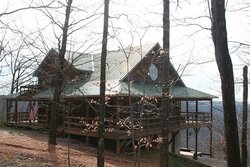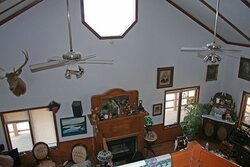Thank you all for the great information contained on this site. I have read and tried to digest as much as I possibly can, but my insecurities as a future first time wood burner find me looking for a little more info.....
I am looking to rip out the ventless gas fireplace our house came with and install a wood stove in it's place. Our home is two storey 40x30 footprint, approx. 1870 cubic feet of airspace, with the future hearth site in a vaulted space 30x20, 20 ft high with 2 ceiling fans. 2nd floor master BR is open loft (8 ft ceiling) with enclosed guest BRs 1 upstairs and 1 down. We currently heat with propane HVAC. Temps here on top of the Boston Mtns. range in the teens-20s, with deep lows to 0 3-4 times per winter. It's been bloody hot this spring thus far.
Red oak, white oak, hickory and cherry we have in abundance on 20 acres. We are still cleaning up damage from an ice storm 2 yrs ago. We are blessed with a remote location. Power was out for over 10 days with that storm, and NOONE drives anywhere when there is ice on the mountain roads... Wood heat will be a real friend! Beats running the generator overtime and trying to store enough gasoline for it.
My concerns in installation are: 1. High winds. We hang off a bluff facing due West. 70 mph howlers come through 5-6 times per year, all seasons.
2. Size of stove to buy.The &$$^#% ventless never did work right. Either would not hold a flame or baked us out when we could keep it going, even on lowest setting. Useless in an emergency. I've been looking at Jotl Oslo, Heartshtone Heritage and Mansfield (appeals to the Victorian decorator in me), though the Alderlea is a possibility...
the warranty on porcelain for Hearthstone is not a confidence builder over the Alderlea, if that is what we go with, dang it.
3. Venting the stove. Current fireplace is centered directly beneath a large octagonal window set at the top of the vault. Best installation for me would be to go through the wall and run majority of chimney pipe outside with a clean-out T (man, standing on that roof is a real rush. There is no way to safety harness up there...) Either I must run the vent pipe directly in front or behind the glass octagon, or I must add a jog to go just to the east side of the octagon and box in the pipe to help keep it warm. The house has a wrap around porch, and so I need to make this jog under the 8' ceiling before heading straight up and through porch roof and climbing to peak of main roof. This is going to be a long run, however it is vented, and if it must bend to pass through the wall AND jog to avoid the window, I am worried about proper draft. Roof is metal. If we vent outside, I can run chimney through the 18" eave/soffit and not have to punch through roof over vaulted ceiling.
Don't you just hate retrofit?!
Every salesman has a different opinion and a girl has to gather as much data as she can to make her best informed decision. Had I more experience with the wonderful world of wood heat, I would have greater confidence in this major project. Any and all assistance is mucho appreciated!
I am looking to rip out the ventless gas fireplace our house came with and install a wood stove in it's place. Our home is two storey 40x30 footprint, approx. 1870 cubic feet of airspace, with the future hearth site in a vaulted space 30x20, 20 ft high with 2 ceiling fans. 2nd floor master BR is open loft (8 ft ceiling) with enclosed guest BRs 1 upstairs and 1 down. We currently heat with propane HVAC. Temps here on top of the Boston Mtns. range in the teens-20s, with deep lows to 0 3-4 times per winter. It's been bloody hot this spring thus far.
Red oak, white oak, hickory and cherry we have in abundance on 20 acres. We are still cleaning up damage from an ice storm 2 yrs ago. We are blessed with a remote location. Power was out for over 10 days with that storm, and NOONE drives anywhere when there is ice on the mountain roads... Wood heat will be a real friend! Beats running the generator overtime and trying to store enough gasoline for it.
My concerns in installation are: 1. High winds. We hang off a bluff facing due West. 70 mph howlers come through 5-6 times per year, all seasons.
2. Size of stove to buy.The &$$^#% ventless never did work right. Either would not hold a flame or baked us out when we could keep it going, even on lowest setting. Useless in an emergency. I've been looking at Jotl Oslo, Heartshtone Heritage and Mansfield (appeals to the Victorian decorator in me), though the Alderlea is a possibility...
the warranty on porcelain for Hearthstone is not a confidence builder over the Alderlea, if that is what we go with, dang it.
3. Venting the stove. Current fireplace is centered directly beneath a large octagonal window set at the top of the vault. Best installation for me would be to go through the wall and run majority of chimney pipe outside with a clean-out T (man, standing on that roof is a real rush. There is no way to safety harness up there...) Either I must run the vent pipe directly in front or behind the glass octagon, or I must add a jog to go just to the east side of the octagon and box in the pipe to help keep it warm. The house has a wrap around porch, and so I need to make this jog under the 8' ceiling before heading straight up and through porch roof and climbing to peak of main roof. This is going to be a long run, however it is vented, and if it must bend to pass through the wall AND jog to avoid the window, I am worried about proper draft. Roof is metal. If we vent outside, I can run chimney through the 18" eave/soffit and not have to punch through roof over vaulted ceiling.
Don't you just hate retrofit?!
Every salesman has a different opinion and a girl has to gather as much data as she can to make her best informed decision. Had I more experience with the wonderful world of wood heat, I would have greater confidence in this major project. Any and all assistance is mucho appreciated!




